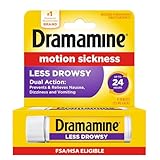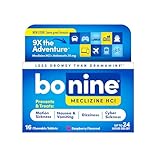
Getting seasick is horrible. I know because I’m a sufferer. Even after living and cruising full-time on a sailboat since 2014, I still have episodes where I turn green and have to use some seasick remedies. Below is everything I’ve ever tried and given to crew members afflicted with the debilitating issue.
The best thing to do about seasickness is to prepare for it to happen
Some drugs and tablets can be taken before a trip, and others can be used when seasickness symptoms present themselves. Sometimes, particular remedies will work in certain conditions, and sometimes, they won’t.
It’s also possible for some seasickness remedies to create other issues – perhaps far worse side effects. For example, when I crossed the Atlantic Ocean (18 days of nonstop sailing and swells), I took a drug for nine days. On the 9th day, my ears plugged up. I then developed an excruciatingly painful earache. After that, I used the chemical patch to reduce my various bouts with nausea and dizziness, but that left a rash on my skin for over three months!
The next thing to do is to get a few different seasickness remedies and try them out
Start with natural seasick remedies, which are least likely to have harmful side effects. Furthermore, it’s important to realize that seasickness will reduce over time. It will improve once your body gets used to being on a boat. When I first started, I puked every trip. Now, I no longer puke and often won’t feel sick unless I’m in a side-to-side motion swell. Perhaps when I’m 80, I’ll be rid of seasickness once and for all?!
Seasickness Gum
One of my favorite seasickness remedies is chewing gum, which settles my stomach. Hard candies also work well. Chewing gum can offer relief from seasickness through several mechanisms. The act of chewing stimulates saliva production, and swallowing this excess saliva helps settle the stomach and reduce nausea.
Additionally, chewing can act as a distraction and relaxation technique, diverting attention from discomfort. The minty or fruity flavors also freshen breath, potentially masking unpleasant tastes or odors that could exacerbate nausea. Some medicated chewing gums even contain dimenhydrinate, an antihistamine absorbed through the mouth lining for quicker relief than traditional pills.
While chewing gum can be a helpful tool for mild seasickness, it’s not a cure-all and may not work for everyone. In severe cases, additional measures like medication or acupressure might be necessary.
Acupressure
Whenever I feel seasick or car sick, I rub the points on my wrist that are supposed to alleviate motion sickness. This is supposed to be one of the top seasickness remedies. It works for a few minutes and can often ward off vomiting, but it doesn’t miraculously make me feel better.
Acupressure, an ancient Chinese practice involving the application of pressure to specific points on the body, can offer relief from seasickness by stimulating the body’s natural healing processes. One of the most commonly used acupressure points for motion sickness is Pericardium 6 (P6), located on the inner wrist.
Applying pressure to this point is thought to harmonize the body’s energy flow, reduce nausea, and alleviate other symptoms of motion sickness, like vomiting and dizziness. Acupressure bands designed to target the P6 point are readily available and can be worn as a preventative measure or for immediate relief during travel.
Aromatherapy
Aromatherapy, using essential oils derived from plants, can offer a natural and holistic approach to managing seasickness. Certain scents, like peppermint, ginger, and lavender, are known for their calming and anti-nausea properties. Inhaling these aromas can help soothe the nervous system, reduce nausea, and alleviate other symptoms of motion sickness like dizziness and headache.
This can be done by diffusing the oils, applying them topically diluted in a carrier oil, or simply inhaling them directly from a tissue or personal inhaler. While more research is needed to understand the mechanisms behind aromatherapy’s effectiveness for seasickness fully, many individuals find it a valuable tool for managing their symptoms and promoting overall well-being during travel.
With aromatherapy, I find that it either works or makes the situation far worse. I tried the Quease Ease, and it almost made me puke instantly. It’s not one of the seasickness remedies I recommend. Strong smells are not a good thing when I’m feeling ill. I have, however, had friends where aromatherapy worked very well.
Ginger Pills
Ginger has always worked for me. I take a ginger pill every morning, and when I forget to take it, I don’t feel very well. By far, ginger has been a fantastically inexpensive and natural remedy that I swear by.
Ginger pills offer a natural remedy for seasickness due to their active compounds, gingerols, and shogaols. These substances work by acting on the digestive and central nervous systems, calming the stomach, reducing nausea, and easing vomiting. Ginger’s anti-inflammatory properties can help alleviate dizziness and other motion sickness symptoms.
Unlike some medications, ginger pills typically have minimal side effects, making them a popular choice for those seeking a gentler alternative. While scientific evidence supporting ginger’s effectiveness for seasickness is ongoing, numerous studies and anecdotal reports suggest its potential as a valuable tool for managing motion sickness and promoting comfort during travel. Often you have to try many seasickness remedies to find what will work best for you.
Over-The-Counter-Drugs
Here are the common seasickness drugs that are available at any drugstore or on Amazon. The important thing with these pills is to take them hours before you get on a boat. If you take them once you start to get sick, they’ll make you feel worse.
Over-the-counter drugs like Bonine and Dramamine offer effective relief from seasickness due to their active ingredients, meclizine, and dimenhydrinate, respectively. These antihistamines work by blocking the action of histamine, a chemical in the body that contributes to feelings of nausea and vomiting.
These medications can alleviate the primary symptoms of motion sickness by suppressing histamine’s effects. While both drugs are generally safe and effective, Dramamine tends to be more potent but may cause drowsiness. On the other hand, Bonine is often considered less sedating, making it a preferred choice for those needing to stay alert. It’s important to consult a doctor or pharmacist before taking these medications, especially if you have any underlying health conditions or are taking other medications.
Other options worth considering
This is one of those strange seasickness remedies. I haven’t tried the headrest yet, but I will certainly try it. When I feel sick, my head gets heavy, so this might just help by keeping my head up!
- LIKE NO OTHER PRODUCT – What makes MotionCure to stand out from other ordinary wristbands, psi bands, patches and drugs solutions, is that it works totally different. To insure the nausea relief MotionCure is targeting the 3 central pathways in the body and brain, responsible for inducing symptoms such as nausea, dizziness and weakness. This fact makes our device LIKE NO OTHER PRODUCT in the market.
- KIDS FRIENDLY – MotionCure is 100% kids & child safe and friendly. Also, MotionCure showed to be 25% more effective with kids in all travel environments.
- FAST RELIEF OF SYMPTOMS- – MotionCure provides relief to motion & morning sickness symptoms within minutes after applying it. If you are happy with the results we offer a 100% MONEY BACK GURANTEE
- TECHNOLOGY BASED SOLUTION – The groundbreaking technology that stands behind MotionCure, is based on both NASA research and the latest scientific breakthroughs in the filled of motion sickness.
- EASY-TO-USE – Unlike other products that require added accessories, MotionCure is a plug-and-play solution for motion & morning sickness, just put it on, press ON and lets it do the rest.
For Dehydration
Sailors are more likely to get seasickness if dehydrated. This is key to seasickness remedies working. Once someone is sick, dehydration becomes a massive issue. It’s bad enough to feel motion sickness, but by adding dehydration to your situation, you’ll want to die. Avoid this at all costs!
Dehydration can worsen or even trigger seasickness. When the body is dehydrated, it struggles to regulate its internal balance, making it more susceptible to the disruptive effects of motion. Dehydration can also lead to low blood pressure and electrolyte imbalances, exacerbating nausea, dizziness, and other symptoms of motion sickness.
Additionally, the medications often used to treat seasickness, such as antihistamines, can further contribute to dehydration. Therefore, maintaining proper hydration by drinking plenty of water or electrolyte-rich beverages is crucial for preventing and managing seasickness.
Other Seasickness Remedies
Besides the remedies mentioned previously, there are several other ways to find relief from seasickness. Focusing on the horizon can help your brain reconcile conflicting signals from your eyes and inner ear, reducing feelings of nausea and dizziness. Getting fresh air by stepping outside or opening a window can also provide relief by offering a change of scenery and clearing the head.
Dietary adjustments can also play a role in managing seasickness. Eating small, bland meals throughout the day can help settle the stomach and prevent nausea from escalating. Avoiding greasy or spicy foods, as well as alcohol and caffeine, is also advisable, as these substances can exacerbate symptoms. Instead, opt for simple crackers, dry toast, or other easily digestible snacks.
Mind-body techniques can also offer relief. Deep breathing exercises can help calm the nervous system and reduce feelings of anxiety, while meditation and mindfulness practices can shift focus away from the discomfort of motion sickness. Additionally, distracting oneself with activities like reading, listening to music, or engaging in conversation can also help take the mind off of the symptoms.
If these measures fail to provide relief, consider trying over-the-counter medications like meclizine (Bonine) or dimenhydrinate (Dramamine), or consult a doctor about prescription options like scopolamine patches. Remember, everyone responds differently to seasickness remedies, so it may take some experimentation to find what works best for you.
If you’ve ever tried some seasickness remedies not listed here and it’s worked for you, please add a comment below. I’m always on the lookout for new seasickness remedies.















This is a really comprehensive list of remedies. Very useful information.
Thank you (as always) Andrew. Appreciate your feedback 🙂
Bravo, good article, well presented and structured.
If you are preventing seasickness, take a tablet for this purpose before going to bed. Because the effect of “Motion seasickness” even acts with closed eyes! In addition to a good night’s sleep, you will have more energy to fight the ….. waves!
(Sorry for my bad English)
Thank you Gaston – that is very important 🙂
I find the best cure for seasickness is to put the person on the helm. They may not want to go on the helm, but insist they do. They will then need to concentrate on helming, and forget about seasickness. It has worked on many occasions.
Totally agree with that Steve. My issue is that I can’t help 24 hrs/day every day for several days. As soon as I stop helming (usually because I get too cold) I’m not feeling well again. For people going out on a day passage this is what we always try first 🙂 Thank you for commenting.
Thanks for the ideas. Hydration, helming and prior medicine before leaving.
SV Belle, Mel n Michelle
And thank you for the comments 🙂
Hi Kim,
You might add Ginger Beer to your list. Unlike any of the medications, it works instantly. We now make our own brew on board.
Hey Trey! Nice to hear from you. Can you let me know what recipe you use for the Ginger Beer?! I’d love to give it a go 🙂
Kim The best remedy we found for my wife was to stop the boat and let her float in the ocean for 5 minutes when possible brought her equilibrium back.
HI Kim,
My other half an I sail quite a lot with Mark Sanders in Portugal, We find ginger tablets work extremely well and don’t give the drowsiness some pills can give.
And ginger is very cheep 🙂
Great watching your adventures BTW
David
Hey David. Say ‘hi’ to Mark from us when you see him next! Yeah, I love ginger…it helped me for years. And your correct that there’s no side affects. I just went out and bought some more for our voyage on Thursday. As long as it doesn’t get too rough they seem to work very well for me… Thanks for the reminder! Kim
While I have not tried it myself I have read other posts to wearing one ear plugs can also work.
Yeah…I’ve tried it. It didn’t work for me but anything is worth a go 🙂 Thank you for commenting Dennis!
Had a injury in the cockpit when working the sheets in rough weather.Got sick real fast after and i must say being seasick is the worst feeling, would do anything to get better. Good luck in your quest to find a cure.
I’m told that the best cure for seasickness is to sit under a tree!!
Seriously though, although I don’t suffer myself I think it important to try prevention first so as you say keep hydrated. Also try to not get overtired, don’t spend long periods down below, particularly if it’s hot, and if you start to feel iffy then a spell on the helm can help – it makes you concentrate and keep your eyes on the horizon. I’m told that it helps to avoid excessive booze the night before and to have plenty of stodgy food before going to sea and to keep food intake up to avoid getting hungry, which I find makes me acidy and prone to nausea.
Once the vomiting starts it’s best to be in a secure bunk with a bucket handy.
Thank you for these great tips Duncan. Love the comment about sitting under a tree 😉
I’ve searched, I find it way too difficult to find that tree in the middle of the ocean 😉
hahahahah. That’s funny!
After a few years on cruise ships it got better. But I remember my first 10 days. It was absolutely awful. And I had to be chipper and work. Don’t know how I got through it. The US has better medication I found. Dramamine worked wonders for me and after a few years I didn’t need them as often. I got accusstomed to being a bit tired. Slept like a log. After passaging the Panama canal I always took a Dramamine since it usually was really bumpy on the Pacific side. I survived 8 years. Would do it again, but on my own boat. It will get better. I promise. The thought of getting seasick can actually trigger it. So staying busy is a good thing. Stay hydrated, avoid fatty food and juices. Keep crackers on hand, don’t get hungry. That helped me. Fair winds!
Great advice Zarih. I have to say that it hasn’t been until this year (after 3 years of sailing) that I’m starting to be okay. I never vomit anymore and I rarely have to lay down. I think it has so much to do with expectation. You have to somehow get your mind away from thinking you’re going to get sick (again). If I can manage to feel better I’m positive that anyone can. Woo Whoo! Thank you for the comments 🙂